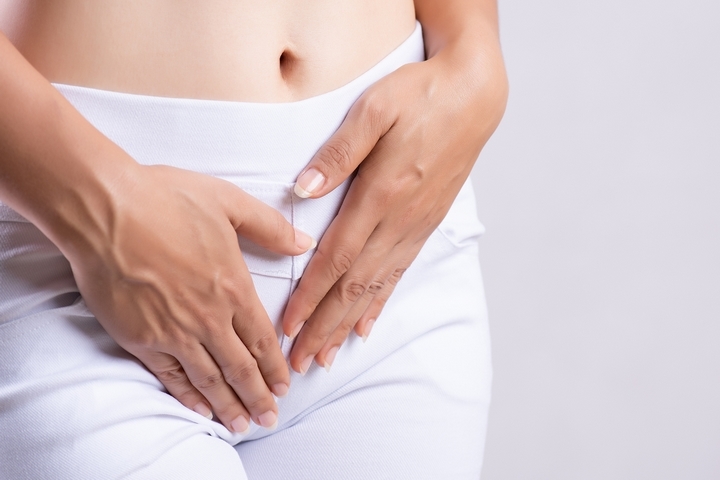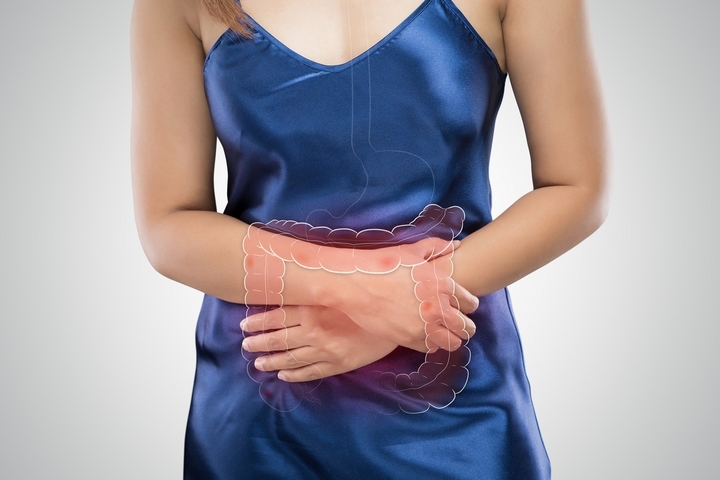Pelvic pain can sometimes be relieved by taking painkillers, or by using a heating pad. Doing light exercise and stretching can also help in some situations.
However, pelvic pain can be serious and require medical attention, especially if it happens regularly, or if it is severe and accompanied by fever, nausea, or vomiting.
If you feel pain in your pelvic region, learning about the pelvic pain causes could help you figure out what is wrong. If you are unsure, you should visit a physiotherapy clinic as soon as possible to help you determine the cause of your pain. A pelvic floor physiotherapy treatment may be recommended to provide you with some relief.
Below are the ten possible pelvic pain causes:
 Menstruation pain is one of the most common pelvic pain causes. In women, pelvic pain can be related to their menstrual cycle. Pain and discomfort can happen when a woman is ovulating, in the middle of her cycle.
Menstruation pain is one of the most common pelvic pain causes. In women, pelvic pain can be related to their menstrual cycle. Pain and discomfort can happen when a woman is ovulating, in the middle of her cycle.
Most women also feel painful cramps just before, and during their periods. Unfortunately, painful periods are common and can come with other symptoms, such as sore breasts and headaches.
Painkillers and heating pads can provide relief, but it’s a good idea to see a doctor if the pain persists when the menstrual period is over.
Cause #2: Constipation and intestinal issues
 Pelvic pain can simply be caused by constipation, which means the pain goes away when we have a bowel movement.
Pelvic pain can simply be caused by constipation, which means the pain goes away when we have a bowel movement.
However, other intestinal issues can cause pain in the lower abdomen or pelvic region, such as irritable bowel syndrome. This condition causes painful intestinal cramps, and can come with other symptoms such as bloating, gas, and diarrhea.
You should see a doctor if you suspect you have IBS.
Cause #3: Urinary tract infection
 Pelvic pain can be caused by a urinary tract infection, which is a bacterial infection that can happen inside your bladder, your ureters, your urethra, or your kidneys.
Pelvic pain can be caused by a urinary tract infection, which is a bacterial infection that can happen inside your bladder, your ureters, your urethra, or your kidneys.
UTIs are mostly common in women, and they can come with symptoms like a burning sensation while urinating, the need to urinate more frequently, and cloudy or bloody urine.
A UTI can lead to cystitis, which is an inflammation of the bladder that also causes pain in the pelvis. If anything seems unusual with your urine, you should see a doctor as soon as possible.
Cause #4: Kidney stones
 Kidney stones are clumps of minerals that can form in your kidneys, and cause severe pain when they move from your kidneys to your bladder. You can also experience symptoms such as bloody urine, fever, nausea, and a burning sensation when you urinate.
Kidney stones are clumps of minerals that can form in your kidneys, and cause severe pain when they move from your kidneys to your bladder. You can also experience symptoms such as bloody urine, fever, nausea, and a burning sensation when you urinate.
Drinking a lot of water could help you evacuate your kidney stones naturally, but large stones usually require medication or surgery.
Cause #5: Sexually transmitted infections
 Sexually transmitted infections like gonorrhea and chlamydia are bacterial infections that don’t always cause symptoms.
Sexually transmitted infections like gonorrhea and chlamydia are bacterial infections that don’t always cause symptoms.
However, they can cause pelvic pain in women, as well as other symptoms such as abnormal vaginal discharge, or bleeding between periods. STIs should be treated with the proper medication.
Cause #6: Appendicitis pain
 Your appendix is a thin tube that is attached to your large intestine, and it can become inflamed and swollen.
Your appendix is a thin tube that is attached to your large intestine, and it can become inflamed and swollen.
The pain related to appendicitis starts suddenly and can be severe, with other symptoms including nausea, vomiting, fever, and swelling of the belly.
The treatment for appendicitis often involves antibiotics and surgery, so it’s important to see a doctor if you think this is the cause of your pelvic pain.
Cause #7: Endometriosis pain
 Endometriosis is a condition in which the tissue that usually lines a woman’s uterus grows in other parts of the pelvis. Since this tissue can’t go anywhere when it starts to shed, it causes pelvic pain before and during a woman’s periods.
Endometriosis is a condition in which the tissue that usually lines a woman’s uterus grows in other parts of the pelvis. Since this tissue can’t go anywhere when it starts to shed, it causes pelvic pain before and during a woman’s periods.
Other symptoms of endometriosis can involve heavy bleeding, constipation, diarrhea, nausea, and fatigue. Medical attention is necessary if the pain and symptoms are severe.
Cause #8: Uterine fibroids
 Uterine fibroids are non-cancerous growths that can form in the wall of a woman’s uterus. Some are very small, while others can form large lumps that will make the belly grow.
Uterine fibroids are non-cancerous growths that can form in the wall of a woman’s uterus. Some are very small, while others can form large lumps that will make the belly grow.
Uterine fibroids don’t always cause symptoms, but they can be responsible for pelvic pain, heavy bleeding during periods, long periods, constipation, and a frequent need to urinate.
Fibroids that cause pain can be removed through different types of medical procedures.
Cause #9: Chronic pelvic pain syndrome
 Chronic pelvic pain syndrome is a condition that can be diagnosed in men who suffer from pelvic pain for at least 3 months, with no obvious cause. This condition comes with pain in the penis and testicles, and it can also involve pain during urination and ejaculation, muscle or joint pain, and fatigue.
Chronic pelvic pain syndrome is a condition that can be diagnosed in men who suffer from pelvic pain for at least 3 months, with no obvious cause. This condition comes with pain in the penis and testicles, and it can also involve pain during urination and ejaculation, muscle or joint pain, and fatigue.
Men who are diagnosed with chronic pelvic pain syndrome can turn to physiotherapy for relief.
Cause #10: Pelvic organ prolapse
 Pelvic organ prolapse is a condition that can affect women of any age, but is more common for older women. It happens when the muscles of the pelvic floor are too weak to properly support the bladder, the uterus, and the rectum.
Pelvic organ prolapse is a condition that can affect women of any age, but is more common for older women. It happens when the muscles of the pelvic floor are too weak to properly support the bladder, the uterus, and the rectum.
Pelvic organ prolapse can cause pain or pressure in the pelvis, and women who suffer from this condition could benefit from pelvic floor physiotherapy.




